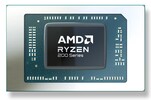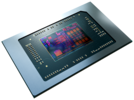AMD Ryzen 5 220 vs AMD Ryzen 3 210 vs AMD Ryzen 3 8440U
AMD Ryzen 5 220
► remove from comparison
The Ryzen 5 220 is a mid-range laptop chip that saw the light of day in early 2025. This Hawk Point family processor isn't actually a new processor; instead, it's a rebadged Ryzen 5 8540U and Ryzen 5 7545U with no differences between the two to report. As such, the R5 220 has two Zen 4 cores and four Zen 4c cores working together under the same roof.
The six cores run at 3.2 GHz to 4.9 GHz and are all SMT-enabled for 12 processing threads. While there is no Ryzen AI support here, at least the users still are getting the modern Radeon 740M integrated graphics adapter.
Architecture & Features
Hawk Point family chips are powered by the Zen 4 architecture, much like Phoenix and Dragon Range family chips are. Unlike Zen 3, Zen 4 features AVX512 support and, thanks to a plethora of other improvements including larger caches/registers/buffers across the board, is slated to deliver a double-digit IPC improvement over the former.
Elswehere, the R5 220 has a 16 MB L3 cache and a very fast DDR5-5600 / LPDDR5x-7500 memory controller. The processor has full USB 4 support and thus Thunderbolt is supported as well. Its fourteen PCIe 4 lanes are more than sufficient for connecting a couple of speedy NVMe SSDs and a discrete graphics card; OS support is limited to 64-bit Windows 11, 64-bit Windows 10 and of course to Linux.
Like most laptop processors sold today, the Ryzen 5 is not overclockable and neither will you be able to replace it with a faster processor as it gets soldered down for good (FP7 or FP7r2 socket interface).
Performance
Due to the same specs as the old Ryzen 5 8540U and Ryzen 5 7545U, the performance is identical to these two older chips and in the mid-range of laptop chips.
Graphics
The Radeon 740M has 4 CUs (256 shaders) at its disposal that run at up to 2,800 MHz. While this iGPU technically supports both ray tracing and DX12 Ultimate, it's not really fast enough for most triple-A games released in 2023 and 2022. It will however let you use up to 4 monitors with resolutions as high as SUHD 4320p, and more importantly it is capable of HW-decoding and HW-encoding the most widely used video codecs including AVC, HEVC and AV1.
Power consumption
This Ryzen 5 series APU has a long-term power limit (default TDP) of 28 W that laptop makers are allowed to change to anything between 15 W and 30 W. Either way, an active cooling solution is a must for any system powered by this chip.
The R5 220 is built with the 4 nm TSMC process for high, as of late 2023, energy efficiency.
AMD Ryzen 3 210
► remove from comparison
The Ryzen 3 210 is a rebadged Hawk Point family processor (APU) that has one Zen 4 core and three Zen 4c cores working together under the same roof. The Ryzen 3 210 is a rebadged Ryzen 3 8440U and R3 7440U and integrates one Zen 4 core and three Zen 4c cores with less cache. It offers 8 threads and run at 3 - 4.7 GHz.
Just like the 7440U, the 210 features the Radeon 740M integrated graphics adapter instead of the more powerful 760M or 780M options. And it comes with no Ryzen AI support, too.
Architecture & Features
Hawk Point family chips are powered by the Zen 4 architecture, much like Dragon Range and Phoenix family chips are. Zen 4 features some rather solid AVX512 support (which Zen 3 chips did not have) and, thanks to a plethora of other improvements including larger caches/registers/buffers across the board, is set to bring a double-digit IPC improvement. Most Hawk Points chips also come with the second-generation Ryzen AI functionality that the R3 210 lacks. Much like replacing full-fat Zen 4 cores with more compact Zen 4c cores, as is the case with this Ryzen 3, that's a way for AMD to get the costs down.
The R3 210 has 8 MB of L3 cache and support for various flavours of DDR5 RAM, up to DDR5-5600 and LPDDR5x-7500 (no ECC support here). It is compatible with USB 4 and thus with Thunderbolt; PCI-Express support is limited to the 4.0 spec for SSD read rates up to 7.8 GB/s, provided a fast NVMe SSD is used. The chip has 14 lanes in total, for reference.
OS support is limited to 64-bit Windows 11 and Windows 10 editions and of course to Linux. The chip is not overclockable, and neither can you replace it with a faster one as it gets soldered down for good (FP7 or FP7r2 socket interface).
Performance
The performance is the same as the old Ryzen 3 8440U and R3 7440U and therefore in the lower middle class.
Your mileage may vary depending on how high the CPU power limits are and how competent the cooling solution of your system is.
Graphics
The Radeon 740M has 4 CUs (256 shaders) purring away at up to 2,500 MHz. This iGPU will let you connect up to four SUHD 4320p monitors and it is capable of both decoding and encoding the most widely used video codecs including AVC, HEVC and AV1. Its gaming performance is fairly unimpressive, as of late 2023; running simpler titles such as CS:GO in resolutions such as HD 720p is the best it can do for you.
Power consumption
This Ryzen 3 series chip has a long-term power limit (default TDP) of 28 W that laptop makers are free to tune. Values between 15 W and 30 W are possible, giving system designers a choice between improving battery life and giving the laptop in question more oomph.
The 210 is built with TSMC's 4 nm* process for high, as of late 2023, energy efficiency.
AMD Ryzen 3 8440U
► remove from comparison
The Ryzen 3 8440U is an oddball Hawk Point family processor (APU) that has one Zen 4 core and three Zen 4c cores working together under the same roof. The 8440U is a rebadged Ryzen 3 7440U with virtually no differences between the two. This is a lower mid-range laptop chip that saw the light of day in late 2023; it offers 8 threads, since all of the cores are SMT-enabled. The highest Boost clock speed that an 8440U can run at is 4.7 GHz and the base clock speed is 3.0 GHz.
Just like the 7440U, the 8440U features the Radeon 740M integrated graphics adapter instead of the more powerful 760M or 780M options. And it comes with no Ryzen AI support, too.
Architecture & Features
Hawk Point family chips are powered by the Zen 4 architecture, much like Dragon Range and Phoenix family chips are. Zen 4 features some rather solid AVX512 support (which Zen 3 chips did not have) and, thanks to a plethora of other improvements including larger caches/registers/buffers across the board, is set to bring a double-digit IPC improvement. Most Hawk Points chips also come with the second-generation Ryzen AI functionality that the 8440U lacks. Much like replacing full-fat Zen 4 cores with more compact Zen 4c cores, as is the case with this Ryzen 3, that's a way for AMD to get the costs down.
The 8440U has 8 MB of L3 cache and support for various flavours of DDR5 RAM, up to DDR5-5600 and LPDDR5x-7500 (no ECC support here). It is compatible with USB 4 and thus with Thunderbolt; PCI-Express support is limited to the 4.0 spec for SSD read rates up to 7.8 GB/s, provided a fast NVMe SSD is used. The chip has 14 lanes in total, for reference.
OS support is limited to 64-bit Windows 11 and Windows 10 editions and of course to Linux. The chip is not overclockable, and neither can you replace it with a faster one as it gets soldered down for good (FP7 or FP7r2 socket interface).
Performance
It's safe to expect the chip to be about as fast as hexa-core Ryzen 4000U options (these are powered by Zen 2) such as the Ryzen 5 4600U, as far as multi-thread performance is concerned. Which is more than enough for the vast majority of day-to-day activities as of late 2023.
Your mileage may vary depending on how high the CPU power limits are and how competent the cooling solution of your system is.
Graphics
The Radeon 740M has 4 CUs (256 shaders) purring away at up to 2,500 MHz. This iGPU will let you connect up to four SUHD 4320p monitors and it is capable of both decoding and encoding the most widely used video codecs including AVC, HEVC and AV1. Its gaming performance is fairly unimpressive, as of late 2023; running simpler titles such as CS:GO in resolutions such as HD 720p is the best it can do for you.
Power consumption
This Ryzen 3 series chip has a long-term power limit (default TDP) of 28 W that laptop makers are free to tune. Values between 15 W and 30 W are possible, giving system designers a choice between improving battery life and giving the laptop in question more oomph.
The 8440U is built with TSMC's 4 nm* process for high, as of late 2023, energy efficiency.
| Model | AMD Ryzen 5 220 | AMD Ryzen 3 210 | AMD Ryzen 3 8440U | ||||||||||||||||||||||||||||||||||||||||||||||||||||||||||||||||||||||||
| Codename | Hawk Point-U (Zen 4 + Zen 4c) | Hawk Point-U (Zen 4 + Zen 4c) | Hawk Point-U (Zen 4 + Zen 4c) | ||||||||||||||||||||||||||||||||||||||||||||||||||||||||||||||||||||||||
| Series | AMD Hawk Point (Zen 4/4c) | AMD Hawk Point (Zen 4/4c) | AMD Hawk Point (Zen 4/4c) | ||||||||||||||||||||||||||||||||||||||||||||||||||||||||||||||||||||||||
| Series: Hawk Point (Zen 4/4c) Hawk Point-U (Zen 4 + Zen 4c) |
|
|
| ||||||||||||||||||||||||||||||||||||||||||||||||||||||||||||||||||||||||
| Clock | 3200 - 4900 MHz | 3000 - 4700 MHz | 3000 - 4700 MHz | ||||||||||||||||||||||||||||||||||||||||||||||||||||||||||||||||||||||||
| L1 Cache | 384 KB | 256 KB | 256 KB | ||||||||||||||||||||||||||||||||||||||||||||||||||||||||||||||||||||||||
| L2 Cache | 6 MB | 4 MB | 4 MB | ||||||||||||||||||||||||||||||||||||||||||||||||||||||||||||||||||||||||
| L3 Cache | 16 MB | 8 MB | 8 MB | ||||||||||||||||||||||||||||||||||||||||||||||||||||||||||||||||||||||||
| Cores / Threads | 6 / 12 2 x 4.9 GHz AMD Zen 4 4 x 4.9 GHz AMD Zen 4c | 4 / 8 1 x 4.7 GHz AMD Zen 4 3 x 4.7 GHz AMD Zen 4c | 4 / 8 1 x 4.7 GHz AMD Zen 4 3 x 4.7 GHz AMD Zen 4c | ||||||||||||||||||||||||||||||||||||||||||||||||||||||||||||||||||||||||
| TDP | 28 Watt | 28 Watt | 28 Watt | ||||||||||||||||||||||||||||||||||||||||||||||||||||||||||||||||||||||||
| Technology | 4 nm | 4 nm | 4 nm | ||||||||||||||||||||||||||||||||||||||||||||||||||||||||||||||||||||||||
| Die Size | 178 mm2 | 178 mm2 | 178 mm2 | ||||||||||||||||||||||||||||||||||||||||||||||||||||||||||||||||||||||||
| max. Temp. | 100 °C | 100 °C | 100 °C | ||||||||||||||||||||||||||||||||||||||||||||||||||||||||||||||||||||||||
| Socket | FP7/FP7r2 | FP7/FP7r2 | FP7/FP7r2 | ||||||||||||||||||||||||||||||||||||||||||||||||||||||||||||||||||||||||
| Features | DDR5-5600/LPDDR5x-7500 RAM, PCIe 4, AES, AVX, AVX2, AVX512, FMA3, MMX (+), SHA, SSE, SSE2, SSE3, SSE4.1, SSE4.2, SSE4A, SSSE3 | DDR5-5600/LPDDR5x-7500 RAM, PCIe 4, AES, AVX, AVX2, AVX512, FMA3, MMX (+), SHA, SSE, SSE2, SSE3, SSE4.1, SSE4.2, SSE4A, SSSE3 | DDR5-5600/LPDDR5x-7500 RAM, PCIe 4, AES, AVX, AVX2, AVX512, FMA3, MMX (+), SHA, SSE, SSE2, SSE3, SSE4.1, SSE4.2, SSE4A, SSSE3 | ||||||||||||||||||||||||||||||||||||||||||||||||||||||||||||||||||||||||
| iGPU | AMD Radeon 740M ( - 2800 MHz) | AMD Radeon 740M ( - 2500 MHz) | AMD Radeon 740M ( - 2500 MHz) | ||||||||||||||||||||||||||||||||||||||||||||||||||||||||||||||||||||||||
| Architecture | x86 | x86 | x86 | ||||||||||||||||||||||||||||||||||||||||||||||||||||||||||||||||||||||||
| Announced | |||||||||||||||||||||||||||||||||||||||||||||||||||||||||||||||||||||||||||
| Manufacturer | www.amd.com | www.amd.com | www.amd.com |
Benchmarks
Average Benchmarks AMD Ryzen 3 210 → 0% n=0
Average Benchmarks AMD Ryzen 3 8440U → 0% n=0
* Smaller numbers mean a higher performance
1 This benchmark is not used for the average calculation













